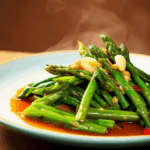Tangy and Sweet Fujianese Oyster Omelette
Welcome to my culinary journey! Today, we’re diving into the heart of Fujian cuisine with a dish that’s both iconic and beloved: the Tangy and Sweet Fujianese Oyster Omelette. This classic street food is not just a meal; it’s an experience that tantalizes your taste buds with its perfect balance of tanginess, sweetness, and savory flavors. Let’s explore how to create this delightful dish at home.
Introduction to Fujianese Oyster Omelette
Fujianese oyster omelette, also known as “Hai Zha Bing” or “Oyster Egg Pancake,” is a quintessential dish from the coastal province of Fujian in southeastern China. The dish has been a staple in Fujian cuisine for centuries, and its popularity has spread far beyond its regional origins. It is often served as a street snack or a light lunch, and its simple yet exquisite flavors have made it a favorite among locals and tourists alike.
The key ingredients in this dish include fresh oysters, eggs, tapioca starch, and a tangy-sweet sauce made from soy sauce, rice vinegar, sugar, and chili paste. The combination of these elements creates a harmonious blend of textures and flavors that is both comforting and exciting. The crispy edges of the omelette contrast beautifully with the tender oysters, while the sauce adds a burst of acidity and sweetness that elevates the entire dish.
Ingredients
- Oysters: 300 grams (fresh or canned)
- Eggs: 4 large
- Tapioca Starch: 3 tablespoons
- Soy Sauce: 2 tablespoons
- Rice Vinegar: 1 tablespoon
- Sugar: 1 teaspoon
- Chili Paste: 1 teaspoon (optional)
- Vegetable Oil: For frying
- Green Onions: 2-3 stalks, finely chopped
- Ginger: 1 small piece, minced
- Garlic: 2 cloves, minced
Preparation
Before you start cooking, make sure all your ingredients are prepared and ready to go. Freshness is crucial for this dish, so if you’re using fresh oysters, make sure they are cleaned thoroughly. If you’re using canned oysters, drain them well and rinse under cold water.
Step 1: Prepare the Oysters
If you’re using fresh oysters, open them carefully and remove the oyster meat from the shells. Discard any broken or damaged oysters. Rinse the oysters under cold water to remove any grit or sand. Pat them dry with paper towels. If you’re using canned oysters, drain them well and rinse under cold water.
Step 2: Whisk the Eggs
In a large bowl, whisk together the eggs until the yolks and whites are fully combined. Add the tapioca starch to the egg mixture and continue whisking until the mixture is smooth and slightly thickened. The tapioca starch helps give the omelette a chewy texture and prevents the eggs from becoming too watery.
Step 3: Prepare the Sauce
In a small bowl, mix together the soy sauce, rice vinegar, sugar, and chili paste. Taste the sauce and adjust the seasoning as needed. The sauce should be tangy, sweet, and slightly spicy. Set aside until ready to use.
Step 4: Cook the Omelette
Heat a non-stick skillet over medium heat and add a thin layer of vegetable oil. Once the oil is hot, pour the egg mixture into the skillet. Spread the mixture evenly across the pan, making sure it covers the entire surface. Sprinkle the oysters evenly over the top of the egg mixture. Let the omelette cook undisturbed for about 2 minutes, or until the edges begin to set.
Using a spatula, gently lift the edges of the omelette and tilt the pan to allow the uncooked egg to flow underneath. Continue cooking for another 2-3 minutes, or until the omelette is golden brown on the bottom and the eggs are mostly set but still slightly runny on top.
Once the omelette is cooked, carefully slide it onto a plate. Cut it into bite-sized pieces and serve immediately.
Step 5: Garnish and Serve
To finish the dish, sprinkle the chopped green onions, minced ginger, and garlic over the top of the omelette. Drizzle the tangy-sweet sauce over the omelette, making sure to cover the entire surface. Serve the oyster omelette warm, either on its own or accompanied by steamed rice or pickled vegetables.
Cooking Tips
When preparing this dish, it’s important to pay attention to the balance of flavors and textures. The sauce should be tangy and sweet, but not overpowering. The oysters should be tender and slightly briny, while the omelette should have a delicate, slightly chewy texture. Here are a few tips to help you achieve the best results:
- Use fresh, high-quality oysters for the best flavor. If you can’t find fresh oysters, canned oysters work well as a substitute.
- Whisk the egg mixture thoroughly to ensure a smooth and even consistency. Adding tapioca starch will help thicken the eggs and prevent them from becoming too watery.
- Be patient when cooking the omelette. Allow it to cook undisturbed for a few minutes before flipping it. This will help create a crispy exterior while keeping the inside soft and tender.
- The tangy-sweet sauce is the star of the dish, so don’t skimp on the seasoning. Taste the sauce before adding it to the omelette and adjust the seasoning as needed.
- For an extra burst of flavor, you can add some finely chopped chili peppers or dried shrimp to the sauce.
Nutritional Information
This dish is not only delicious but also nutritious. Oysters are a great source of protein, vitamins, and minerals, including zinc, iron, and vitamin B12. Tapioca starch provides a good amount of carbohydrates, while eggs offer a healthy dose of protein and essential fats. The sauce is low in calories but adds flavor without adding too much fat or sodium.
| Ingredient | Calories | Protein (g) | Carbohydrates (g) | Fat (g) |
|---|---|---|---|---|
| Oysters | 81 kcal | 11 g | 2 g | 1 g |
| Eggs | 155 kcal | 13 g | 1 g | 11 g |
| Tapioca Starch | 367 kcal | 0 g | 92 g | 0 g |
| Sauce | 20 kcal | 0 g | 4 g | 0 g |
Variations and Pairings
While the traditional Fujianese oyster omelette is delicious on its own, there are many ways to vary the recipe to suit your personal preferences. You can add other ingredients like shrimp, pork, or vegetables to the omelette for extra flavor and nutrition. You can also experiment with different types of sauces or seasonings to create your own unique version of this classic dish.
When serving the oyster omelette, consider pairing it with steamed rice, pickled vegetables, or a side salad. These accompaniments complement the flavors of the omelette and provide a balanced meal. You can also enjoy the omelette as a snack or appetizer, especially during the cooler months when you’re looking for something warm and comforting.
Conclusion
The Fujianese oyster omelette is a dish that embodies the rich culinary heritage of Fujian province. Its perfect balance of flavors and textures makes it a true delight for the senses. Whether you’re a seasoned chef or a novice in the kitchen, this dish is sure to impress your friends and family. With its simple ingredients and straightforward preparation, it’s a dish that anyone can master with a little practice. So why not give it a try? You’ll be amazed at how easy it is to create this delicious and satisfying meal at home.


